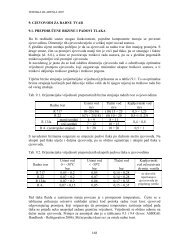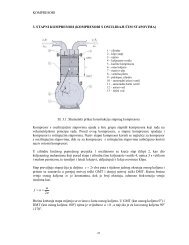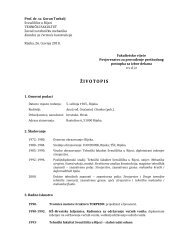universityâenterprise cooperation
universityâenterprise cooperation
universityâenterprise cooperation
Create successful ePaper yourself
Turn your PDF publications into a flip-book with our unique Google optimized e-Paper software.
102<br />
profit that provides a return to investors.<br />
In general, companies manage science for<br />
profit and often prefer to protect confidential<br />
information from early disclosure, as can be<br />
seen in Figure 1.<br />
Competition in the market place requires<br />
short development times and proper<br />
management of intellectual property that<br />
restricts publication of research outcomes.<br />
However, modern society based on knowledge,<br />
economy growth and better living conditions<br />
can not be achieved without close <strong>cooperation</strong><br />
between universities and enterprises.<br />
Interactions between universities and<br />
enterprises are beneficial to both sides. Benefits<br />
to universities come from complementing<br />
their own academic research and from<br />
commercialization of research results. Benefits<br />
to companies come from increased access to<br />
new university research and discoveries.<br />
6.2 Benefits for key actors in the<br />
knowledge triangle<br />
It is widely acknowledged that the<br />
commercialization of scientific and<br />
technological knowledge produced in public<br />
funded research institutions, including<br />
universities and research centers, to the<br />
marketplace have a fundamental role to play<br />
in wealth creation, supports economic growth<br />
and technological innovation, and plays<br />
a significant role in new venture creation,<br />
growth of existing firms and new job creation.<br />
All actors in the knowledge triangle (Figure 2)<br />
should have benefits from university-enterprise<br />
<strong>cooperation</strong> bearing in mind large number of<br />
people included in this triangle. Universities<br />
are repositories of knowledge about future<br />
technological, economic, and social trends due to<br />
numerous stakeholders (internal and external). The<br />
major stakeholders are academics, researchers,<br />
professionals, students, institutional leaders<br />
and managers, national governments, national<br />
agencies and advisory bodies, supranational<br />
bodies (World Bank, OECD, etc.), and businesses<br />
and industry (including both multinational and<br />
small- and medium-sized enterprises – SMEs).<br />
University-enterprise <strong>cooperation</strong> can take<br />
many forms from which key actors in the<br />
knowledge triangle should have benefits. In<br />
what follows some of them are described.<br />
In the field of teaching and training, benefits<br />
of key actors can be through:<br />
• Industry participation in academic planning<br />
and course design;<br />
• In-kind support by industry (donation<br />
of equipment, student scholarships,<br />
teaching grants);<br />
• Secondment of staff by industry to<br />
university as part-time professors,<br />
visiting professors, etc.;<br />
• Industry provision of on-the-job training<br />
opportunities (summer jobs) and of parttime<br />
work opportunities;<br />
• Delivery of specialized courses by universities<br />
(continuing education, executive development,<br />
specialized customized programs);<br />
• Participation of university professors in<br />
industry-led professional development<br />
activities, faculty consulting in industry,<br />
participation on company Boards and<br />
other industry-driven committees.<br />
In the field of research, industrial support to<br />
the university can be through the following<br />
activities:<br />
• Research grants and research contracts;<br />
• Donation of equipment;<br />
• Access to industry research facilities.<br />
The transfer of knowledge and technology from<br />
universities to enterprises occurs through a<br />
number of pathways, but the most prominent<br />
pathways are:<br />
• The training of students (theses, class<br />
projects, practice);<br />
• The publication of research results in the<br />
scientific or technical publications;<br />
• Common participation in conferences<br />
and seminars.<br />
Other methods that result in the transfer of<br />
knowledge are through:
















